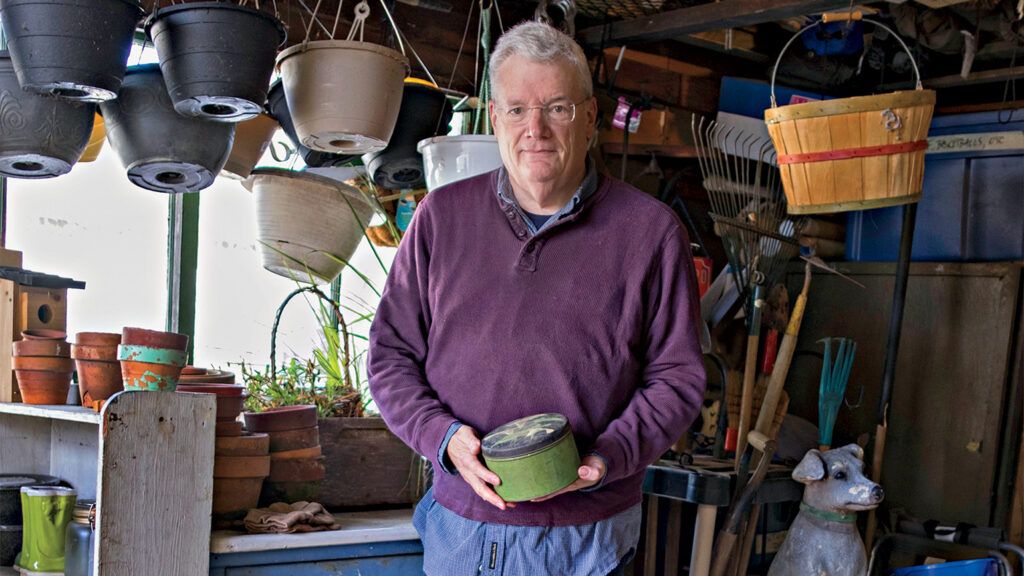One of the first things my wife, Peg, said when I retired was “Good news! Now you’ll have time to clean the garage!” Not exactly good news—it was the one task I’d been putting off. I pushed at the garage’s wooden doors, but they were as stubbornly stuck as I felt in this new stage of my life. This detached garage—along with our house—was more than a hundred years old. I finally got the doors open and stepped onto the wide plank floor.
Inside were gaps so big you could see all the way down to the ground. We’d even discovered a family of foxes denning underneath last spring. Not that it was safe for parking, but there was no way to squeeze a car inside anyway, with all the junk that had piled up over the 32 years since we’d moved here. Since I’d started my job.
I’d earned my degree in broadcast journalism at Syracuse University and gotten a job as the news director of a radio station north of New York City. After our first child was born, we moved farther north, to Albany, where we could be near family. I hosted radio and television programs with the state legislators.
I felt as if God had led me to a place where I could use my skills, helping lawmakers communicate with their constituents. I’d even worked my way up to director of the office. Then I developed some serious medical issues and, after 30 years’ service, knew it was time to retire. After decades of long hours and stringent deadlines, now what?
This musty garage didn’t seem like much compared to the marble halls of the state capitol. Sure, I would have more time to spend with my granddaughters, six-year-old Grace and four-year-old Lily, and to help out my mom, who was 90, but I worried I’d lose the sense of purpose and identity I had felt in my profession.
I picked my way past coolers, snow shovels and folded tarps. Here I was puttering, of all things. I raised my eyes to the rafters, where cobwebs hung like hazy film. God, is this what it’s come to? Do you still have a use for me? I pulled on work gloves, then hefted a crate of motor oil out of the way, intending to empty some shelves.
I reached all the way back to the wall, and my hand hit something hard. What could that be? I pulled out a grungy, round metal tin. With one finger, I wiped away a thick layer of dust on the lid to reveal a green background with white lilies.
I thought back to when I was a young boy, watching my father clean out my grandfather’s house after he’d died. Dad pulled out fistfuls of money that had been stashed everywhere— under the mattress, behind the Bible, even wrapped in foil and tucked in the freezer. Could this old tin hold a hidden fortune?
Little by little, I loosened the cover until it popped off and clanked to the ground. I held my breath. Inside were several yellowed envelopes. I opened one, and my heart sank.
Peg poked her head inside the garage door. “What’s that?”
“Seeds,” I said. Nothing but seeds.
Peg walked over to inspect the tin’s contents. “Look, here’s a letter.” She held up a faded envelope with a three-cent stamp and a postmark of May 13, 1940. Before I was born! The letter was addressed to the original owner of our house.
“‘I am sending you the seeds of the hibiscus you admired when you stopped at our tourist home last year,’” Peg read. “‘Plant when the ground becomes warm, and do not be alarmed if they do not come up for several weeks—they are slow to germinate.’”
“Huh,” I said. “Eighty years old. I wonder if they’ll still grow?” I had several hanging pots and a few flower beds, but I was no expert. I grabbed a plastic garden tray where I’d recently planted zinnia seeds, shook the hibiscus seeds out of the envelope, pushed them into the soil and set the tray on the patio table in the sun.
“What are my chances?” I asked my neighbor, an experienced gardener, about the octogenarian seeds. “Not very good,” he said, “but maybe… if they were packed right and kept dry and dark.”
Every day when I was out in the yard with our golden retrievers, Ernest and Petey, I checked the tray. Within a week, the zinnias were poking up. But not the hibiscus. “I guess they’re just too old to be any good,” I told Peg with a sigh. After I transplanted the zinnias into the ground, I checked again. Nothing. I picked up the tray to get rid of it, but something made me hesitate. I set it aside behind the garage.
In the meantime, I was keeping busy. I’d taken up running several years ago and had competed in a few 5Ks. Now I had the time to train for a marathon. I’d long been interested in photography, especially of dogs, and I bought several books on the subject to improve my skills. I taught Grace and Lily everything I knew about gardening and dogs, which turned out to be more than I’d thought.
Six weeks after I planted the old seeds, I was out in the yard playing with Ernest and Petey when I happened to notice the tray. There in the damp soil, a sprig of green had emerged. I toted the tray back to the patio table for a better look. Was it just grass? A stray zinnia? A weed? Or could it be…?
I found myself checking first thing every morning, until one day I saw leaves unfurled, leaves that looked just like the illustration of a hibiscus plant that I’d found online. I potted the seedling in a handsome terra-cotta pot and proudly showed off the broad, healthy leaves to Peg and our granddaughters.
“Look, girls, even something this old can still grow and be pretty cool, right? Just like your papa!”
Like the little hibiscus that could, with God’s help I would keep growing too.
For more inspiring stories, subscribe to Guideposts magazine.





